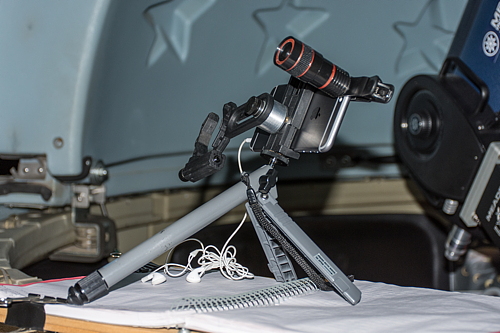iPhone 8X Telephoto Lens Tests;
DSLR Two Faint Comets
Posted: 24 February 2017
Tuesday, 21 February 2017, was clear during the day, but the sky became cloudy as sunset approached. Wednesday, 22 February, dawned mostly clear, but again was cloudy as sunset approached. Thursday, 23 February, dawned clear and stayed clear but windy all day. I took a photo of the waning crescent Moon in the morning sky using a handheld iPhone 6s Plus and a newly received inexpensive ($15) clip-on 8X telephoto lens:


I will be doing more astrophotography tests with this lens.
The wind was still blowing pretty good until well after sunset. I delayed opening the observatory until the wind had decreased somewhat.
|
Open: Thursday, 23 February 2017, 1846 MST Temperature: 59°F |
Session: 1075 Conditions: Clear, breezy |
Equipment Used:
12" f/8 LX600 w/StarLock
Wired AutoStar II handset
2" 24mm UWA eyepiece
2" 9mm 100° eyepiece
2" 2X PowerMate
Camera:
iPhone 6s Plus
D7200 DSLR
After I opened the observatory I set up the iPhone 6s Plus with the clip-on 8X telephoto lens to see if I could photograph the crescent phase of Venus with the iPhone and telephoto lens:

Unfortunately, I could not get a good focus with the Camera app or the NightCap Pro app. I will do more tests on the next session.
1915 MST: LX600 ON, StarLock OFF, High Precision OFF.
Viewed Venus, 102X and 542X. The crescent phase is getting thinner. Venus was now too low in the sky to try imaging. Hope to do that on the next session.
I then began setting up to image Comet 2P/Encke, very low in the western sky and very faint. Mounted the D7200 DSLR at prime focus + focal reducer. Focused on Venus. 1934 MST: Wi-Fi adapter ON. Used SkySafari 5 Pro on the iPhone to command the 12" telescope to slew to Comet Encke. StarLock ON. Surprisingly, the StarLock autoguided well for such a low elevation object. This is a 1 minute, autoguided, ISO 2500, White Balance 4000K image of the faint Comet 2P/Encke:

A thin faint tail is visible at 11 o'clock from the comet's head.
1955 MST: ended Comet Encke imaging. Wi-Fi OFF, StarLock OFF.
2002 MST: viewed Comet Encke, 102X. The head was nicely visible but no tail was seen in the eyepiece.
Next, slewed the 12" telescope to the star Rigel to check if seeing was good enough this night to try imaging Sirius B, the "Pup Star". Rigel's companion star was easily seen at 542X. The Pup Star has about the same separation from Sirius A. I focused Rigel using the Bahtinov Mask and then mounted the iPhone 6s Plus on the eyepiece using the Levenhuk adapter. I did some video recordings of Rigel, afocal 542X, using the iOS app NightCap Pro. This is a cropped frame from one of the videos, with Rigel's companion star at 7 o'clock from Rigel:

Removed the phone and slewed to the star Sirius. I might have seen the Pup Star but confirmation was difficult. I mounted the iPhone and as I began to do a video recording with NightCap Pro the iPhone shutdown due to a low battery and the cold temperature (about 40°F). Argh. So no attempt at imaging the Pup Star this night.
My next imaging target was to be Comet 45P/Honda-Mrkos-Pajdusakova, which was also faint in the northeastern sky. But as I planned to use SkySafari 5 Pro to GOTO the comet and my iPhone was not available I went back to the house to get my iPad Pro 9.7". With the iPad then in the observatory, I turned the observatory Wi-Fi ON and used SkySafari to go to Comet 45P. No obvious comet was visible in the eyepiece (102X). It turned out that the solar system database in SkySafari Pro on the iPad was way out-of-date (Nov 2016). After I let the app update the database I did another GOTO to the comet; still nothing obvious. Decided to try imaging anyway. Mounted the D7200 DSLR at prime focus + focal reducer. Focused with the Bahtinov Mask using the star Regulus.
2118 MST: StarLock ON. GOTO Comet 45P/Honda-Mrkos-Pajdusakova using SkySafari 5 Pro. This is a 1 minute, autoguided (on a star), ISO 5000, WB 4000K, image showing the faint comet (at the left):

This is a 5 minutes, autoguided (on a star), ISO 5000, WB 4000K, image showing the comet's rapid motion:

2131 MST: ended comet imaging. StarLock OFF, Wi-Fi OFF. Unmounted the DSLR. Viewed Comet 45P/Honda-Mrkos-Pajdusakova, 102X. It was very faint with a large but diffuse coma. No tail was visible.
Then began closing up for the night.
|
Close: Thursday, 23 February 2017, 2153 MST Temperature: 39°F |
Session Length: 3h 07m Conditions: Clear, breezy |
I have updated my Vortex Diamondback 12x50 Binoculars review with the addition of the Vortex Uni-Daptor tripod adapter.
Comments are welcome using Email. Twitter users can use the button below to tweet this report to your followers. Thanks.
Cassiopeia Observatory Home Page
Copyright ©2017 Michael L. Weasner / mweasner@me.com
URL = http://www.weasner.com/co/Reports/2017/02/24/index.html
